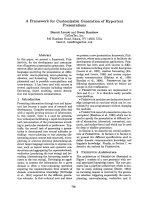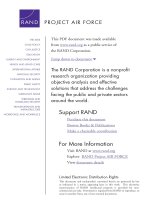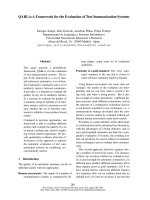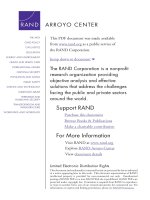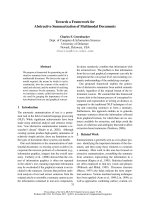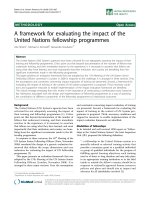Foundations of Effective Influence Operations - A Framework for Enhancing Army Capabilities potx
Bạn đang xem bản rút gọn của tài liệu. Xem và tải ngay bản đầy đủ của tài liệu tại đây (1.37 MB, 227 trang )
This document and trademark(s) contained herein are protected by law as indicated
in a notice appearing later in this work. This electronic representation of RAND
intellectual property is provided for non-commercial use only. Unauthorized
posting of RAND PDFs to a non-RAND Web site is prohibited. RAND PDFs are
protected under copyright law. Permission is required from RAND to reproduce,
or reuse in another form, any of our research documents for commercial use. For
information on reprint and linking permissions, please see RAND Permissions.
Limited Electronic Distribution Rights
Visit RAND at www.rand.org
Explore RAND Arroyo Center
View document details
For More Information
This PDF document was made available
from www.rand.org as a public service of
the RAND Corporation.
6
Jump down to document
THE ARTS
CHILD POLICY
CIVIL JUSTICE
EDUCATION
ENERGY AND ENVIRONMENT
HEALTH AND HEALTH CARE
INTERNATIONAL AFFAIRS
NATIONAL SECURITY
POPULATION AND AGING
PUBLIC SAFETY
SCIENCE AND TECHNOLOGY
SUBSTANCE ABUSE
TERRORISM AND
HOMELAND SECURITY
TRANSPORTATION AND
INFRASTRUCTURE
WORKFORCE AND WORKPLACE
The RAND Corporation is a nonprofit
research organization providing
objective analysis and effective
solutions that address the challenges
facing the public and private sectors
around the world.
Purchase this document
Browse Books & Publications
Make a charitable contribution
Support RAND
This product is part of the RAND Corporation monograph series.
RAND monographs present major research findings that address the
challenges facing the public and private sectors. All RAND mono-
graphs undergo rigorous peer review to ensure high standards for
research quality and objectivity.
Eric V. Larson, Richard E. Darilek, Daniel Gibran,
Brian Nichiporuk, Amy Richardson, Lowell H. Schwartz,
Cathryn Quantic Thurston
Prepared for the United States Army
Approved for public release; distribution unlimited
ARROYO CENTER
Foundations of
Effective Influence
Operations
A Framework for Enhancing
Army Capabilities
The RAND Corporation is a nonprofit research organization providing
objective analysis and effective solutions that address the challenges facing
the public and private sectors around the world. RAND’s publications do
not necessarily reflect the opinions of its research clients and sponsors.
R
®
is a registered trademark.
© Copyright 2009 RAND Corporation
Permission is given to duplicate this document for personal use only, as long
as it is unaltered and complete. Copies may not be duplicated for commercial
purposes. Unauthorized posting of RAND documents to a non-RAND
Web site is prohibited. RAND documents are protected under copyright law.
For information on reprint and linking permissions, please visit the RAND
permissions page ( />Published 2009 by the RAND Corporation
1776 Main Street, P.O. Box 2138, Santa Monica, CA 90407-2138
1200 South Hayes Street, Arlington, VA 22202-5050
4570 Fifth Avenue, Suite 600, Pittsburgh, PA 15213-2665
RAND URL:
To order RAND documents or to obtain additional information, contact
Distribution Services: Telephone: (310) 451-7002;
Fax: (310) 451-6915; Email:
Library of Congress Cataloging-in-Publication Data
Foundations of effective influence operations / Eric V. Larson [et al.].
p. cm.
Includes bibliographical references.
ISBN 978-0-8330-4404-4 (pbk. : alk. paper)
1. United States. Army—Planning. 2. Influence (Psychology) 3. United States—
Relations—Foreign countries. 4. United States—Foreign public opinion. 5. United
States—Military policy. 6. Diplomacy. 7. Strategy. 8. Communication, International.
9. Information warfare—United States. 10. Economic assistance, American.
I. Larson, Eric V. (Eric Victor), 1957–
UA23.F625 2009
355.4'1—dc22
2008053723
The research described in this report was sponsored by the United States
Army under Contract No. W74V8H-06-C-0001.
iii
Preface
Since the end of the Cold War, there has been growing interest in
improving the nation’s ability to employ various forms of “soft power”—
capabilities that might allow the United States to effectively influence
the attitudes and behavior of particular foreign audiences while mini-
mizing or avoiding combat entirely. e present study was undertaken
to assist the U.S. Army in understanding “influence operations” and
to identify approaches, methodologies, models, and tools that may be
useful in planning, executing, and assessing influence operations.
is research was sponsored by the U.S. Army Training and Doc-
trine Command’s (TRADOC’s) Futures Center. It was conducted in
the RAND Arroyo Center’s Strategy, Doctrine, and Resources Pro-
gram. RAND Arroyo Center, part of the RAND Corporation, is a
federally funded research and development center sponsored by the
United States Army.
Please direct any comments or additional information to the prin-
cipal investigator, Eric V. Larson, at 310.393.0411 extension 7467 or
e Project Unique Identification Code (PUIC) for the project
that produced this document is DAPRR05007.
iv Foundations of Effective Influence Operations
For more information on RAND Arroyo Center, contact the
Director of Operations (telephone 310-393-0411, extension 6419; FAX
310-451-6952; email ), or visit Arroyo’s Web
site at />v
Contents
Preface iii
Figures
vii
Table
ix
Summary
xi
Acknowledgments
xxi
Abbreviations
xxiii
CHAPTER ONE
Introduction 1
Defining Influence Operations
2
Study Questions and Approach
6
Organization of is Report
8
CHAPTER TWO
Influencing Individuals 11
Engineering Attitude Change
18
Influencing Individuals: Conclusions
23
CHAPTER THREE
Influencing Groups and Networks 29
Behavioral Perspectives Regarding Groups
29
Rational Choice Perspectives Regarding Groups
34
Influence in Social Networks
38
Influencing Groups and Networks: Conclusions
41
vi Foundations of Effective Influence Operations
CHAPTER FOUR
Influencing Adversary Leadership Coalitions 43
Actor-Specific Models and Strategies
43
Agent-Based Rational Choice Models
46
Influencing Adversary Leadership Coalitions: Conclusions
51
CHAPTER FIVE
Influencing Mass Publics 53
Opinion Leadership and Media Communications
58
Content Analysis
59
Semantic Network Analysis
63
Assessing Mass Public Opinion
65
Lessons from Case Studies
67
Influencing Mass Publics: Conclusions
69
CHAPTER SIX
A Framework for Influence Operations 71
Planning Requirements
71
Questions About Strategic Issues
71
Questions About the Target Audiences
74
Some Additional Planning Considerations
81
A Framework for Influence Operations: Conclusions
83
CHAPTER SEVEN
Implications for Planners 85
APPENDIX
A. Case Study of Influence in Advertising and Marketing 89
B. Case Study of Influence in Political Campaigns
111
C. Case Studies of Influence in Public Diplomacy
133
D. A Review of Planning Methodologies for
Influence Operations
155
Bibliography
179
vii
Figures
S.1. Elements of Influence Operations xiii
1.1. Elements of Influence Operations
5
2.1. Attitude Objects in Multidimensional Space
21
2.2. Alternative Domains for Persuasive Appeals
24
5.1. A Simple Model of Influence for Mass Publics
54
6.1. Notional Probability of Accepting a Message Based on
High, Medium, or Low Predisposition
80
B.1. Diagramming an Electorate
117
B.2. Impact of Direct Mail During 1994 Texas Governor’s
Race
128
D.1. Air Force View of EBOs’ Basic Principles
161
D.2. Matrix of Levels of Planning Versus Conflict Phases
167
ix
Table
D.1. EBOs and Influence and Information Operations Applied
to a Specific Military Objective: Defeat or Compel
Capitulation of Enemy Forces
160
xi
Summary
Since the end of the Cold War—and as witnessed by the U.S. military
actions in the Gulf War, Kosovo, Afghanistan, and Iraq—the U.S.
military is likely to prevail in conventional major combat operations
against virtually any plausible adversary or combination of adversaries
in a conventional military contest. Nevertheless, the United States has
faced an entirely different set of challenges in securing the peace, which
hinges less upon military prowess than on the ability to employ various
forms of soft power.
Even before the attacks of September 11, 2001, there was a grow-
ing realization that the U.S. image in much of the Muslim world may
have been facilitating the mobilization and recruitment of Islamic
jihadists committed to the destruction of the United States. e sub-
sequent difficulties the United States encountered in fostering stable
political equilibria in Iraq and Afghanistan sparked additional interest
in capabilities that might assist the United States in securing peace and
stability by influencing target audiences while minimizing or avoiding
combat entirely.
A good deal of attention presently is focused on how to improve
the nation’s capabilities to influence others. ese capabilities include
public diplomacy, strategic communications, information operations,
and other means that can be used to influence attitudes, behaviors, and
decisions—i.e., “win hearts and minds”—without resort to (or exces-
sive reliance on) the use of force. As will be described, we use the term
influence operations to describe such efforts, whether the target audience
is a specific leader, select elites or members of a decisionmaking group,
xii Foundations of Effective Influence Operations
military organizations and personnel, specific population subgroups, or
mass publics. e aims of this study were fourfold:
Define influence operations in an operationally useful way.•
Review the scholarly literature related to influence operations.•
Describe the elements of a general model for effective influence •
operations and provide a framework for integrating influence
operations into military campaigns.
Provide a description and critique of available approaches, meth-•
odologies, and tools that might assist in planning, executing, and
assessing influence operations.
Defining Influence Operations
In Chapter One, we provide a definition of influence operations:
Influence operations are the coordinated, integrated, and synchro-
nized application of national diplomatic, informational, military,
economic, and other capabilities in peacetime, crisis, conflict, and
postconflict to foster attitudes, behaviors, or decisions by foreign
target audiences that further U.S. interests and objectives.
In this view, influence operations accent communications to affect
attitudes and behaviors but also can include the employment of mili-
tary capabilities, economic development, and other real-world capabili-
ties that also can play a role in reinforcing these communications (see
Figure S.1).
Somewhat serendipitously, our definition bears a striking resem-
blance to a recently approved definition of strategic communications:
Focused US Government efforts to understand and engage key
audiences in order to create, strengthen, or preserve conditions
favorable for the advancement of US Government interests, poli-
cies, and objectives through the use of coordinated programs,
Summary xiii
Figure S.1
Elements of Infl uence Operations
RAND MG654-S.1
IO
Diplomacy
Public
diplomacy
STRATCOMM
Clandestine
Economic
Military/
paramilitary
force
Other
“on the
ground”
Synchronization/
coordination/
integration only
PA
IO
Diplomacy
Public
diplomacy
STRATCOMM
Clandestine
PA
CMO
(including
CA)
plans, themes, messages, and products synchronized with the
actions of all instruments of national power (DoD, 2006, p. xii).
1
us, readers can generally conceive of infl uence operations as
synonymous with strategic communications in the world of joint
operations.
1
By comparison, the Air Force defi nition, as of November 3, 2006 (U.S. Air Force Air
University, 2006), was the following:
Informing and appropriately infl uencing key audiences by synchronizing and integrat-
ing communication eff orts to deliver truthful, timely, accurate, and credible informa-
tion: Strategic refers to source of information, message, messenger, audience, timeframe,
and/or eff ect; Communication refers to both what you say and what you do; Requires
focus on both internal and external communication eff orts; and Requires both peace-
time and wartime processes and capabilities.
xiv Foundations of Effective Influence Operations
Review of the Scholarly Literature
In Chapters Two through Five, we review the scholarly literature related
to influence operations at the individual level (Chapter Two), the group
and network level (Chapter ree), the adversary leadership coalition
level (Chapter Four), and the mass public level (Chapter Five) and iden-
tify approaches, models, and tools that might assist in the planning,
execution, and assessment of influence operations. e following are
among the conclusions reached:
Influencing Individuals.• ere is an abundance of theories and
models that seek to explain individual-level attitudes, persuasive
communications, and behavioral change, and although several
appear to be relatively generalized and empirically robust, even the
best of these have relatively modest explanatory power. In light of
the uncertainties regarding which sorts of appeals are most likely
to result in attitude or behavioral change, planners would do well
to embrace an adaptive process that tests the relative efficacy of
cognitive, emotional, and social appeals and that modifies com-
munications accordingly.
Influencing Groups and Networks.• Among the more promising
behavioral models at the group and network level are models of
social power, opinion leadership, and the diffusion of innovations.
ese models can help to explain influence and the diffusion of
ideas within groups and networks, and they suggest that target-
ing those who are influential and are opinion leaders constitutes
an effective and efficient influence strategy. Research on factors
affecting group performance and social choice theories of group
decisionmaking suggests other points of leverage for influencing
group dynamics and decisionmaking that are available to influ-
ence planners, including manipulation of information, agendas,
and group decision rules.
Influencing Adversary Leadership Coalitions.• Scholars have identi-
fied a wide range of influence strategies, including deterrence and
coercive diplomacy, to achieve political-military objectives against
adversary leaders and coalitions, in addition to diagnostic criteria
Summary xv
for evaluating the likely efficacy of these strategies. Other schol-
ars have developed agent-based rational choice or expected utility
models that have a good predictive track record and appear to
provide a sound basis for forecasting the outcome of influence
efforts, developing policy and strategy, and identifying key stake-
holder groups that should be targeted. Taken together, this body
of work can assist planners in identifying which target audiences
should be the focus of their efforts and which are less important.
Influencing Mass Publics.• Planners can benefit from an under-
standing of the roles of opinion leadership and individuals’ infor-
mation environments in the diffusion of attitudes among mass
publics, perhaps especially the credibility of different leaders and
information channels and the processes by which members of the
public become aware of messages, accept or reject these messages,
and change attitudes or behaviors on the basis of the messages
they receive.
ese various literature areas provide a complementary and highly
integrative set of microfoundations and macrofoundations for under-
standing the determinants of influence.
A General Model for Influence Operations
In Chapter Six, we identify nine key planning questions that can be
used to guide the development of influence operations. ese questions
can generally be divided into those dealing with strategic-level issues
and those dealing with target audiences.
e first four questions focus on the strategic-level picture and the
underlying political dynamics related to achievement of U.S. coalition
objectives:
What are current U.S. objectives? Are current objectives likely to •
be achieved, and if not, what outcomes are most likely under pres-
ent or plausible conditions?
xvi Foundations of Effective Influence Operations
Which actors or groups are most influential in political-military •
outcomes?
What strategies (e.g., force or negotiation) are most likely to influ-•
ence these groups and yield desired outcomes?
How much authority/influence do group leaders have over their •
supporters/followers?
ese questions are likely to be of greatest interest to the White
House, to National Security Council staff, and to such interagency
actors as the Departments of State and Defense. ey will also interest
the regional component commander and joint force commander and
most likely would need to be addressed by intelligence analysts work-
ing for the services, the Department of Defense, or the larger intelli-
gence community.
Five additional questions need to be answered for each of the key
target audiences identified during influence strategy development so
that effective substrategies can be developed for each:
Which sources and information channels do target audiences use •
and find most credible?
How are target audiences’ attitudes structured, and how stable •
are they?
What messages are they already receiving?•
What message sources, content, and formats are most likely to be •
accepted and to foster change?
How many messages need to be sent to them? What other actions •
need to be taken to achieve influence objectives?
Notwithstanding the vast uncertainties regarding the likely effi-
cacy of influence efforts, we believe that this analytic protocol can help
planners focus on key issues that need to be understood and to narrow
the range of options to the most practical, effective, and efficient ones.
Summary xvii
Analytic Tools for Supporting Influence Operations
Furthermore, we identify how various social science approaches and
tools might be used to assist in answering these questions, focusing on
those approaches and tools that we feel might be profitably employed
in planning and executing influence operations but perhaps are not as
well known as they deserve to be.
e first two tools may be helpful in assessing strategic-level
issues:
Agent-Based Rational Choice • or Expected Utility Modeling appears
to be highly suitable for use in developing influence strategies and
illuminating the first three strategic-level questions. In particular,
we view this tool as being useful for identifying which stakeholder
groups are likely to be most important to a political outcome and,
therefore, are most deserving of influence efforts. We judge this to
be a mature technology that is ready for operational use in plan-
ning influence strategies and operations.
Social Network Analysis (SNA)• tools appear to be quite useful
for describing, in a visual way, formal political or administra-
tive, tribal, patronage, clerical, and other networks that, taken
together, constitute a nation’s authority structure. We see SNA
tools as potentially useful in bootstrapping an understanding of
these authority structures and in identifying key leaders (nodes)
who should be targeted by influence efforts. ere also is some
recent theoretical work—as yet unsupported by empirical evi-
dence that might provide the desired level of confidence that the
theories are more than plausible guesses—that focuses on influ-
ence within networks and that ultimately may prove to be valu-
able to planners.
We also identify two approaches that we believe might be useful for
assessing communications in a competitive information environment:
Automated Content Analysis• is an approach for analyzing texts that
seems likely to be useful for influence operations. In particular,
we see content analysis as a tool for tracking the content of foreign
xviii Foundations of Effective Influence Operations
leadership statements and media reports, for ascertaining whether
strategic communications messages are penetrating key media,
and for similar limited purposes. We judge automated content
analysis to be a mature technology that should be relatively easy
to adapt to operational use for these purposes.
Semantic Network Analysis• is another technique for analyzing
texts that is primarily used by communications researchers. e
approach is similar to social network analysis insofar as it uses
nodes and links (or relational ties), the defining feature of which is
that a connection of some form is established between the nodes.
In the case of semantic networks, however, the links typically are
between words or people using words. is approach ultimately
may be helpful in developing tools for summarizing texts or
assessing meaning, but we judge that the approach is still some-
what immature and will require further testing and refinement
before it is likely to be operationally useful.
Finally, we identified an analytic approach that can be used to
map attitude structures and to provide a generalized environment for
reasoning about and designing persuasive communications.
Galileo Metric Multidimensional Scaling was one of the most
interesting approaches we came across in our survey of social science
approaches that might be suitable for supporting influence operations.
In many ways, this theory was the closest any social science approach
came to providing a framework for thinking about how to effect atti-
tude changes for planning, conducting, and assessing the impact of
influence operations on attitudes and behaviors. e approach is based
on survey instruments that ask respondents to judge the distances (a
proxy for similarities or differences) between relevant attitude objects
(e.g., people, places, things, or events, toward which one may have an
attitude). e approach uses advanced factor analytic techniques to
construct a multidimensional map of attitude objects in a common
cultural “space.” ese maps can be used for identifying potentially
potent themes for influence messages and for measuring any resulting
change. We judge that the operational utility of Galileo for the analysis
of attitudes and influence messages should be tested and assessed for
possible operational use.
Summary xix
Implications for Planners
Our reviews of the social science literature related to influence at the
levels of the individual, group and network, adversary leadership coali-
tion, and mass public and our case studies of influence in commer-
cial advertising and marketing, American-style political campaigns,
and public diplomacy (Appendixes A through C) suggest that there
are a number of characteristics that seem to be associated with effective
influence operations:
ey are aimed at achieving • specific desired objectives and effects,
typically a change in a key attitude, belief, preferred policy, or
behavior.
ey are directed toward • key target audiences, whether an indi-
vidual, a decisionmaking group, a military unit, a population sub-
group, or the mass public of a nation.
ey make use of the most effective combination of • information
channels—i.e., those channels that are both most likely to reach
the target audience and are most likely to be viewed as unbiased
and credible.
ey are mindful of • audience characteristics, including preexisting
attitudes and beliefs that may condition an audience’s willingness
to be influenced.
ey are • timed to influence actors before they decide or act, in the
case of leaders and decisionmaking groups, or before attitudes crys-
tallize, in the case of mass audiences.
ey make use of messengers with compelling • source characteris-
tics—i.e., those whose professional or technical competence, like-
ability, credibility, trustworthiness, or confidence makes them
effective spokespersons.
ey rely upon messages with • compelling message characteristics—
i.e., those whose content, format, cognitive and emotional appeal,
and other characteristics will most resonate with the audience.
ey • facilitate adaptation by providing timely feedback on effects
so that information channels, messengers, themes, messages, etc.
can be modified to increase their persuasiveness.
xx Foundations of Effective Influence Operations
In achieving these desiderata, planners should be mindful of three
practical implications that result from the heterogeneity of the schol-
arly literature, the absence of a larger meta-theory of influence, and the
situational or context dependence of persuasion efforts:
e various theories described above can provide only starting 1.
points for planners and operators; they will need to be adapted or
fashioned to meet the specific requirements of each situation.
Even after detailed analysis, vast uncertainties are likely to 2.
remain regarding the efficacy of various alternative approaches
to communication of messages to target audiences.
e vast uncertainties associated with the enterprise of influence 3.
lead to the requirement for an adaptive, robust, metrics-based
planning, execution, and assessment process that can under-
write a capability to plan, test, and assess the results of different
sorts of strategies, communications, and appeals and to modify
the approach based on the results. e requirements of such a
metrics-based process for influence operations are well beyond
the scope of the present effort and are described in some detail
in other, related work (Larson et al., forthcoming).
By constructing influence campaigns on solid theoretical and
empirical foundations at the micro and macro levels, and testing and
adapting target audience responses to these efforts, planners are far
more likely to avoid pitfalls and, in some cases, even achieve their influ-
ence objectives.
However, as described in this report, the required level of intel-
lectual and analytic effort for such endeavors can be substantial. e
effort may in many cases not only outstrip the capabilities of planning
staffs but also may require more intensive inputs and effort than their
results perhaps merit.
xxi
Acknowledgments
We thank the sponsor of this study, COL Bob Johnson of the U.S.
Army Training and Doctrine Command’s Army Capabilities Integra-
tion Center, for the opportunity to do such interesting work. We also
appreciate the comments from the following individuals on various
aspects of this study: LTC Chuck Eassa and LTC Kenneth Krumm of
the U.S. Army Information Operations Proponent, Combined Arms
Center, Ft. Leavenworth, Kansas; and Paul E. Funk, director of the
Institute for Advanced Technology at the University of Texas in Austin
and chairman of the Army Science Board’s panel on information oper-
ations. We also thank Joseph Woelfel, professor at the University of
Buffalo, for information on the Galileo metric multidimensional scal-
ing system and Alexander L. George, who was Graham H. Stuart Pro-
fessor Emeritus of International Relations at Stanford University until
his death in August 2006.
We also thank Kori Schake of the United States Military Acad-
emy, West Point, and RAND colleague James Kahan for their help-
ful reviews, and Lauri Zeman and Tom Szayna, program director and
associate program director, respectively, of RAND Arroyo Center’s
Strategy, Doctrine, and Resources program.
xxiii
Abbreviations
ABP assumption-based planning
ANOVA analysis of variance
AOD Air Operations Directive
ATO Air Tasking Order
CA civil affairs
CBP capabilities-based planning
CENTCOM U.S. Central Command
CHAID chi-squared automatic interaction detector
CIA Central Intelligence Agency
CMO civil-military operations
COG center of gravity
DIME diplomatic, informational, military, and
economic
DoD Department of Defense
EBO effects-based operation
ELM Elaboration Likelihood Model
EUM expected utility modeling

